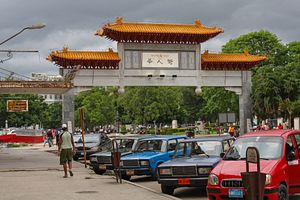A communist power is yet again perched at America’s doorstep, only this time it may be for the benefit of all. China’s growing presence in the Caribbean will only be a boon, however, if it can learn to work in harmony with locals.
Last month Colombian officials detained Wu Hong, captain of the Chinese vessel Da Dan Xia, en route to Cuba. The ship’s cargo, listed as grain, was actually 100 metric tons of gunpowder, 3,000 cannon shells, and 3 million detonators. Chinese foreign ministry spokesperson Hua Chunying called it “a normal cooperation in military trade.”
Let’s not forget, the U.S. has its own sordid history in this area. Jefferson believed the U.S. “ought […] to take Cuba,” and when the grito de Baíre rang out, America turned its back on the rebels. Also, after the Spanish-American War, the U.S. agreed to withdraw its troops from Cuba (wait for it…) in exchange for the right to keep its troops in Cuba — specifically naval troops on leased land at Guantánamo Bay. Then the U.S. supported General Batista’s barbaric reign (1940–1959) and allowed American corporations to exploit locals. When Fidel Castro began nationalizing American businesses, the U.S. began an embargo, invaded the country, and tried to murder him.
Meanwhile, China has provided weapons, automobiles, and medicine and invested in nickel processing at Las Camariocas and oil drilling off the coast of Pinar del Río (Britain previously expressed interest in Cuban off-shore oil, but the U.S. changed its mind). In 2006, when Barbados was hit with U.S. sanctions for not signing an Article 98 agreement to protect Americans from the International Criminal Court (ICC), China gave it economic aid. China is also a major stakeholder in the Caribbean Development Bank (CDB), based in Barbados, which finances social and economic programs — the U.S. is not a member.
Earlier this month in Jamaica, U.S. President Barack Obama commented on China’s growing presence in the region, saying the concern was with China “using its sheer size and muscle to force countries into subordinate positions.” He also cautioned against a lack of transparency and the practice of using Chinese workers for overseas projects. Chinese Foreign Ministry spokesperson Hua Chunying replied, “Speaking of ‘size and muscle,’ I believe everyone knows well who has the largest ‘size and muscle’ in the world.”
Hua has a point. In the islands, the U.S. has played the bully for years, while China has been gaining a reputation for comforting and aiding America’s Caribbean whipping-boys. But Obama also has a point — the lack of transparency and use of Chinese workers has already created problems. Recent Bahamian headlines, for instance, have been dominated by the Baha Mar project, a $3.5 billion resort, the largest of its kind in Bahamian history and, according to one report, “China’s largest overseas commercial real-estate project.” But to complete it, China brought 4,000 Chinese workers to a nation with 16 to 20 percent unemployment. In addition, the lack of transparency has caused serious employee payroll and scheduling problems.
Once finished, the resort will likely be a success, adding to China’s charm offensive in the region: a renovated hospital in Dominica, a power plant in Antigua and Barbuda, and the residence of the prime minister of Trinidad and Tobago are just a few examples of the love Beijing has been spreading around. If its ventures bring stability, Caribbean nations might even develop the strength to crack down on the local drug route, a main artery during the 1980s and 90s and still a source of corruption and crime. But if China takes handsome profits home without contributing meaningfully to the local economy, this surging red tide, if you will, could end up sucking all the oxygen out of the water.
There is, at least, hope for cultural congress. Much of the Caribbean already enjoys a fusion of Chinese-Caribbean heritage — Chinese-Jamaican descendants include Tyson Beckford, Naomi Campbell and Staceyann Chin; artist Wifredo Lam was of Chinese-Cuban descent, and painter Edouard Wah was a Chinese-Haitian. There are even Chinese-Caribbean landmarks, like Los Chinos de Ponce, a Chinese-owned Puerto Rican shop that makes possibly the best ice cream in the Caribbean.
Others are getting their first taste of Chinese culture. My mother, a Bahamian who has never visited China, saw Spring Festival decorations for the first time in Nassau this year. She said they were beautiful.

































